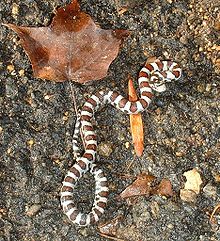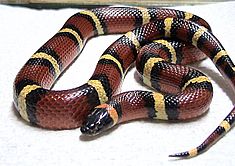- Milk Snake
-
Milk snake red milk snake Lampropeltis triangulum syspila Scientific classification Kingdom: Animalia Phylum: Chordata Class: Reptilia Order: Squamata Suborder: Serpentes Family: Colubridae Genus: Lampropeltis Species: L. triangulum Binomial name Lampropeltis triangulum
(LaCépède, 1788)[1]Synonyms Coluber triangulum LaCépède, 1788
Pseudoëlaps Y Berthold, 1843
Ablabes triangulum - Duméril & Bibron, 1854
Lampropeltis triangula - Cope, 1860
Coronella triangulum - Boulenger, 1894
Osceola doliata triangula - Cope, 1900The milk snake or milksnake (Lampropeltis triangulum; French: Couleuvre tachetée; Spanish: Culebra-real coralillo, Lithuanian: Pieninė gyvatė)[1] is a species of king snake. There are 25 subspecies among the milk snakes, including the commonly named scarlet kingsnake (L. t. elapsoides).[1] The subspecies have strikingly different appearance, and many of them have their own common names. Some authorities suggest that this species may be split into several separate species.[1]
Contents
Geographic range
They are distributed from southeastern Canada, through most of the continental United States, to Central America, down to western Ecuador and northern Venezuela of northern South America.[1][2]
Description
Milk snakes grow 20 to 60 inches (51 to 150 cm) long.[1] They have smooth and shiny scales and their typical color pattern is alternating bands of red-black-yellow or white-black-red.[1] However, red blotches instead of bands are seen in some populations.[1] Some milk snakes have a striking resemblance to coral snakes and this mimicry (known as Batesian mimicry) likely scares away potential predators. While both milk snakes and coral snakes possess transverse bands of red, black and yellow, a common mnemonic can be used to properly distinguish between the deadly coral snake and the harmless milk snake:
-
- "Red on yellow will kill a fellow, but red on black is a friend of Jack."
- "Red on yellow, deadly fellow; Red on black, venom lack."
- " Red and yellow will kill you fellow; Red and black is friend Jack."
- "Red on yellow, kill a fellow. Red on black, you're alright Jack."
- "Red next to black is a friend of Jack; red next to yellow will kill a fellow."
- "Red to yellow, kill a fellow. Red to black, venom lack."
- "If red touches black, you're okay Jack; if red touches yellow, you're a dead fellow."
- "Red next to black, you can pat him on the back; red next to yellow, he can kill a fellow."
- "Red next to black, venom I lack; red next to yellow, run away fellow."
- "Red and black, friend of Jack; red and yellow kill a fellow."
- "Red touches yellow, Not a nice fellow; if red touches black, good friend of jack."
- "Red touch yellow, kill a fellow; red touch black, you're okay Jack."
However, the Eastern milk snake (L. t. triangulum) does not resemble a coral snake; instead it tends to have similar markings to that of several other snakes, particularly the fox snake, scarlet snake and most importantly, the Massassauga rattlesnake. Milk, fox, and scarlet snakes are killed because of a resemblance to the venomous rattlesnake. Juvenile milk snakes, which are more reddish than adults, are often killed because they are mistaken for copperheads. There is enough distinction among the five to make the Eastern milk snake fairly easy to identify. Eastern milk snakes also have a light colored v-shaped or y-shaped patch on their neck. One subspecies is melanistic (almost all black).[1]
Habitat
Across the wide range of this species, habitat varies. Typically, milk snakes live in forested regions; however, in some regions they can be located in open prairies. In various parts across its distribution, milk snakes often abide in rocky slopes.[1]
Behavior
Milk snake activity is mostly nocturnal. They are primarily terrestrial, except the scarlet kingsnake which is known to take shelter under the bark of standing dead trees. They also try to blend in with dead leaves.
Diet
Young milk snakes typically eat slugs, insects, crickets, and earthworms.[3] Adult diet frequently includes lizards (especially skinks), and small mammals.[1] They are also known to eat birds and their eggs, frogs, fish, and other snakes.[3]
Milk snakes are much more opportunistic eaters than the fox snake or corn snake. They have been known to consume a variety of animals including rodents, eggs, birds, reptiles, amphibians, and invertebrates. Nevertheless the diet of an adult milk snake still primarily consists of rodents. They are nocturnal eaters and are often found during the day in old barns and under wood.
An early myth about milk snakes is that they suck cow udders to get the milk. The myth is entirely false, and is discredited by the fact that the milk snake does not have the physical capabilities to suck milk out of a cow. Milk snakes are, however, frequently found in and around barns, making use of their cool and dark environments, and for the easily accessed populations of rodents to feed on. This proximity to barns, and therefore cows, probably gave rise to the myth.[1]
Reproduction
Milk snakes are oviparous, laying an average of about 10 eggs per clutch, although that number may vary by region.[1] The milk snake mates from early May[3] to late June. In June and July, the female lays three to twenty-four eggs beneath logs, boards, rocks, and rotting vegetation.[3] The eggs incubate for approximately two months, and hatch around August or September.[3] Milk snakes typically live around twelve years.[3]
Conservation status
The milk snake is not listed by the IUCN (a wildlife conservation union), but in some areas, they may face significant pressure due to pet trade collection.[1] Because this species' high value in the pet trade, many subspecies are now being bred in captivity for sale.[1]
Subspecies
- Guatemalan Milksnake, L. t. abnorma (Bocourt, 1886)
- Louisiana Milksnake, L. t. amaura (Cope, 1861)
- Andean Milksnake, L. t. andesiana (Williams, 1978)
- Mexican Milksnake, L. t. annulata (Kennicott, 1861)
- Jalisco Milksnake, L. t. arcifera (Werner, 1903)
- Blanchard's Milksnake, L. t. blanchardi (Stuart, 1935)
- Pueblan Milksnake, L. t. campbelli (Quinn, 1983)
- New Mexico Milksnake, L. t. celaenops (Stejneger, 1903)
- Conant's Milksnake, L. t. conanti (Williams, 1978)
- Dixon's Milksnake, L. t. dixoni (Quinn, 1983)
- Scarlet Kingsnake L. t. elapsoides (Holbrook, 1838)
- Black Milksnake, L. t. gaigeae (Dunn, 1937)
- Central Plains Milksnake, L. t. gentilis (Baird & Girard, 1853)
- Honduran Milksnake, L. t. hondurensis (Williams, 1978)
- Ecuadoran Milksnake, L. t. micropholis (Cope, 1860)
- Pale Milksnake, L. t. multistrata (Kennicott, 1861)
- Nelson's[4] Milksnake, L. t. nelsoni (Blanchard, 1920)
- Pacific American Milksnake, L. t. oligozona (Bocourt, 1886)
- Atlantic Central American Milksnake, L. t. polyzona (Cope, 1861)
- Sinaloan Milksnake, L. t. sinaloae (Williams, 1978)
- Smith's[4] Milksnake, L. t. smithi (Williams, 1978)
- Stuart's Milksnake, L. t. stuarti (Williams, 1978)
- Red Milksnake, L. t. syspila (Cope, 1889)
- Utah Milksnake, L. t. taylori (Tanner & Loomis, 1957
- Eastern Milksnake, L. t. triangulum (Lacépède 1788)
References
- ^ a b c d e f g h i j k l m n o Savitzky, Alan H. (2004), Hutchins, Michael; Evans, Arthur V.; Jackson, Jerome A. et al., eds., Grzimek's Animal Life Encyclopedia, 7: Reptiles (2nd ed.), Detroit: Gale, p. 477, http://go.galegroup.com
- ^ Armstrong, Michael P.; Frymire, David; Zimmerer, Edmund J. (December 2001), "Analysis of sympatric populations of Lampropeltis triangulum syspila and Lampropeltis triangulum elapsoides, in western Kentucky and adjacent Tennessee with relation to the taxonomic status of the scarlet kingsnake", Journal of Herpetology 35 (4): 688–93, doi:10.2307/1565915, JSTOR 1565915, http://vnweb.hwwilsonweb.com/hww/jumpstart.jhtml?recid=0bc05f7a67b1790e050a2140da939dde29bfd13582719af621eb734dba33044f9d443e023694dc49&fmt=P
- ^ a b c d e f "Encyclopedia of Animals (Milk snake entry)", EBSCO Animals (EBSCO Publishing), http://search.ebscohost.com/login.aspx?direct=true&db=ani&AN=9500200390&site=ehost-live
- ^ a b Bell, Edwin L.; Smith, Hobart M.; Chiszar, David (2003), "An Annotated List of the Species-Group Names Applied to the Lizard Genus Sceloporus." (PDF), Acta Zoologica Mexicana (90): 103–174, http://redalyc.uaemex.mx/redalyc/pdf/575/57509006.pdf
- Species Lampropeltis triangulum at The Reptile Database
External links
Categories:- Lampropeltis
- Fauna of Mexico
- Reptiles of North America
- Reptiles of South America
- Fauna of Delaware and Maryland
- Reptiles of the United States
- Animals described in 1788
- Pet snakes
- Reptiles of Guatemala
-
Wikimedia Foundation. 2010.



